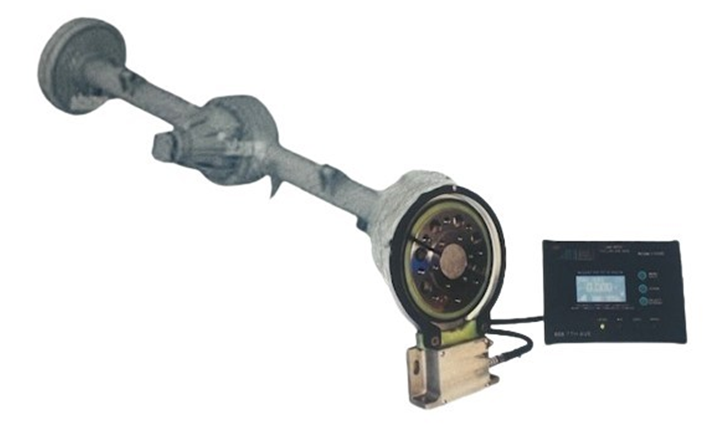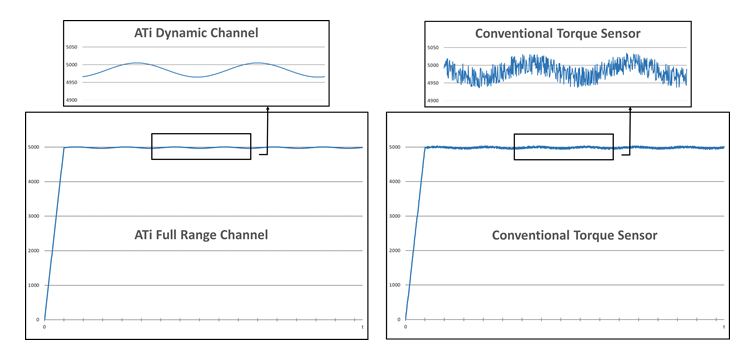For manufacturers of axles and automotive powertrain components, a significant hurdle in end-of-line testing has been accurately capturing gear mesh torsional data without it being obscured by the sensor’s noise floor. Today, we are going to tell you how to overcome this with ATi’s Dynamic Sensing System.
Unlocking the Secrets of NVH Data with Advanced Torque Sensing Technology
Noise, vibration, and harshness (NVH) are the invisible foes of automotive engineering. Capable of turning an otherwise smooth ride into a less comfortable experience. One of the key challenges in combating NVH issues is capturing precise gear mesh torsional data. Traditional torque sensors, although widely used, often fall short in their ability to detect the subtle nuances necessary for detailed NVH analysis. This is where the innovative technology of ATi Dynamic Torque Sensing Systems shines. Therefore, transforming the landscape of NVH testing and analysis.
The Limitations of Conventional Torque Sensors
Conventional torque sensors, with a typical sensing system of 5000 Nm, face a significant hurdle: a noise floor of about 20 Nm (peak to peak). Since gear mesh data for a standard internal combustion engine (ICE) related axle or drive module usually falls below this threshold, critical NVH data is lost, submerged in the sensor’s noise floor. Although some systems attempt to overcome this by offering an AC output. However, this is essentially an amplified version of the original signal. Therefore, the noise floor remains unchanged, hovering around 20 Nm.
A New Standard with ATi 5000 Nm Dynamic Torque Sensing System
The ATi 5000 Nm Dynamic Torque Sensing System sets a new benchmark. Achieved with its remarkably low noise floor of 0.1 Nm and an impressive bandwidth up to 19 kHz. This makes it an industry standard for end-of-line testing among axle and automotive powertrain component manufacturers. Its capability to capture even the most elusive NVH data with precision is unmatched. Thereby, offering a clear window into the intricacies of gear mesh and other torsional data.
Going Wireless with Precision: The ATi 2100 Series
For situations where conventional wireless rotary torque transducers can’t measure up, the ATi 2100 Series Digital Wireless Dynamic Torque Sensing Systems come into play. They excel in capturing accurate gear mesh measurements, which are typically less than 1% of static torque levels and would otherwise be lost with standard sensors. Read detailed information on how this product operates.

Dual Range Dynamic Torque Sensing Solutions
ATi’s innovation continues with its Dual Range Dynamic Torque Sensing Solutions, featuring two independent channels. The full range static channel caters to a wide range of torque levels, while the dynamic channel focuses on lower levels with precise sensitivity. This dual-channel approach ensures that even under high static torque levels, the dynamic details are not lost.
RF Telemetry and Induction Power: A Robust Combination
The use of RF telemetry and induction power for data and power transfer ensures that these systems are resilient to environmental factors like dust and oil. This technology allows for significant movement between the rotating sensor and stationary loop antenna without compromising signal quality, making setup and maintenance more straightforward than ever.
Beyond Torque: Torsional Acceleration Monitoring
ATi doesn’t stop at torque. Their Torsional Acceleration Monitoring Systems provide additional layers of NVH data, with both torsional and radial acceleration channels available, pushing bandwidth capabilities up to 19 kHz. This comprehensive approach to monitoring enables a deeper understanding of NVH factors, paving the way for more effective solutions.
Conclusion: Revolutionising NVH Analysis with ATi
The challenge of capturing accurate NVH data is no small feat. But with ATi’s advanced torque sensing technology, the automotive industry now has the tools to delve deeper into the complexities of noise, vibration, and harshness. These systems not only elevate the precision of NVH analysis but also offer versatility and resilience against environmental factors, setting a new standard for end-of-line testing and beyond. In the quest for smoother rides and quieter engines, ATi’s innovative solutions are leading the way, making once-elusive data accessible and actionable. To learn more contact us.
The Problems this System could help solve
The ATi Dynamic Torque Sensing Systems and related NVH analysis equipment are designed to solve a range of complex problems for customers, particularly in the automotive, manufacturing, and engineering sectors. Here’s a breakdown of the key issues these products address:
1. Inadequate Sensitivity in Torque Measurement
Problem: Conventional torque sensors often have a limited dynamic range, making it difficult to capture low-level torque fluctuations.
Solution: ATi’s systems offer a significantly lower noise floor, enabling the detection of subtle torque variations critical for detailed analysis.
2. Loss of Critical NVH Data
Problem: Essential NVH data can be lost with traditional sensors due to their inability to detect small, yet significant, vibrations or noises.
Solution: With high bandwidth and precision, ATi’s technology captures a wide spectrum of NVH data, ensuring that even the most minute disturbances are recorded.
3. Challenges in Gear Mesh Analysis
Problem: Gear mesh levels, crucial for understanding gear health and operation, are typically below the noise floor of standard sensors.
Solution: The enhanced sensitivity and dynamic range of ATi’s systems allow for accurate gear mesh analysis, facilitating early detection of potential issues.
4. Wireless Data and Power Transfer Issues
Problem: Traditional sensors may require complex wiring for power and data transfer, complicating installation and limiting mobility.
Solution: ATi’s use of RF telemetry for data and induction power for energy supply simplifies setup, enhances flexibility, and reduces maintenance efforts.
5. Inefficiencies in End-of-Line Testing
Problem: End-of-line testing processes may lack the precision needed to ensure product quality, leading to potential defects.
Solution: The high-resolution and fast sampling rates of ATi’s systems provide detailed insights during end-of-line testing, improving product reliability.
6. Environmental Susceptibility
Problem: Dust, oil, and other environmental factors can interfere with sensor performance, affecting accuracy.
Solution: ATi’s sensors are designed to be immune to environmental contaminants, ensuring consistent performance in various conditions.
7. Alignment and Movement Limitations
Problem: Many sensors require precise alignment and are sensitive to movement, which can be restrictive and challenging to maintain.
Solution: The tolerance for significant movement and misalignment without loss of signal quality in ATi’s systems offers greater installation flexibility and durability.
8. Detailed EV Component Testing
Problem: Electric vehicle (EV) components present unique testing challenges. Due to the high precision required to measure electric motor and gear reducer phenomena.
Solution: ATi’s dynamic torque sensors provide the necessary resolution and bandwidth to accurately test and analyse EV components. Supporting the development of quieter and more efficient vehicles.
In essence, ATi’s Dynamic Torque Sensing Systems and NVH analysis equipment offer comprehensive solutions. Including the intricate challenges of torque measurement and NVH data acquisition. By providing detailed, reliable, and easily accessible insights, these products help customers improve product quality. In addition, enhance performance, and accelerate development cycles across a range of applications.
To learn more, contact us.
